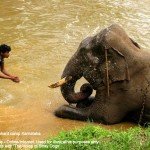Elephants in captivity are not a good thing. Elephants in zoos. Elephants in temples. Elephants in ‘Elephants in Elephant camps’. Elephants are slaves and captive labor at best. Beggars at worst. But they don’t just become it. They’re trained. They’re broken. And the Govt does it in its watch. And you know about the ‘rogue’ elephants that are caught and they put to task! Well they just disappear looks like. India needs only happy well adjusted pachyderms. India is still the land of elephants and snake charmers in the Incredible India brochures, right?
The following is an account of 2 individuals travelling together to the Sakrebailu Elephant (training camp). This one is 300 Kms. from Bengaluru, 12 Km from Shimoga. And Karanataka is dotted with many – in Dubare, Chamarajanagar and Nagarhole. The latter 3 are considered more ‘upmarket’ – Sakrebailu more approachable and more importantly is the one where you’re allowed to ‘interact’ with the elephants. As the Central Govt website says for Sakrebailu:
“On the way to Thirthahalli from Shimoga, 14 kms away from the city you can hear elephants reciting their lessons. Yes its not a joke its fact that you can find here many elephants being trained by training professionals. Elephant from the adjoining forests bathe at this spot before they re-enter their forest abode. Every morning these majestic creatures waddle down to waters and after playfully cleansed their bodies and satiated their thirst, they leave the waters before the rays of the sun get stronger. They are off to deal with their day’s routine only to return the following day. To catch a glimpse of these mammoths at play in the waters, get there before 9 a.m.”
Idyllic surroundings no doubt. In the shrinking land of elephant – a slice of paradise. Kaustubh Dharkar and Naina Athale (both from Mumbai) went to Shakrebailu on 22 June 2014 to soak in the paradise.
But before we continue please watch this video. No please. Its important that you watch it and not turn your eyes away. Tomorrow this is the elephant you will give money to at a temple, or ride at a camp like this or come to Karnataka or Kerala or any of the ‘elephant states’ seeing it in a slick brochure. The video is shaky because it was unexpected and Kaustubh Dharkar’s hand was shaky.
This is Kaustubh Dharkar:
“My spouse and I were vacationing in Karnataka alongwith our friends the Athales in June 2014. We stopped over at Shimoga on the 21st and 22nd June 2014. We were informed about some tourist spots around Shimoga which we decided to visit. One of these places was the Sacrebyle Elephant Park, about 14 Km from Shimoga. We were informed that the Camp is for training of elephants and that it is a happy place for the pachyderms who are well looked after by the staff, bathed in the backwaters of the dam, well fed and generally lead a happy life. It is specially a camp for the rehabilitation of elephants who have been abused elsewhere like in temples and circuses.
“We arrived at the Camp on the 22nd June 2014 full of expectations of happy elephants gamboling in the open spaces and interacting with humans. What we saw there shocked us terribly with the appalling cruelty and abuse to which the poor elephants were subjected.
“What we noticed immediately was that most elephants including the baby elephants were tightly shackled to strong pegs driven into the ground with strong chains which definitely must have caused injuries on their skins, due to the tightness of the chains. Other elephants were tied using big rough rope. The lengths used did not permit the animals even a few inches of movement which must have been very uncomfortable.
“But what was more appalling was the abuse that we saw being heaped on a baby elephant who seemed to have got entangled in his rope, possibly while attempting to get near its mother. The staff and mahouts trying to cut the rope lacked any empathy for the baby elephant and kept trying to get it to do their bidding by walloping the poor animal with sticks. It was heartbreaking to hear the pitiful cries of the baby who obviously did not understand the instructions. It also appeared to me that the staff was deriving pleasure from the animal’s agony.
“When the abuse got too violent we intervened in trying to stop them from the beatings. That was when one of the handlers explained to us that they were “TRAINING” the animals. He also admitted that “the only way that the animals can be trained to entertain humans was to beat them into submission!” I am glad that I managed to get the entire episode videoed on my mobile. It has been posted on YouTube.
“Makes us wonder that if such abuse can be administered during the Camp’s open hours of 7 AM to 11 AM in the presence of visitors, what horrors are heaped when the Camp is shut for 21 hours? And I also wonder at the silence of the visitors who silently watch the cruelties and maybe consider them entertainment?
“I demand that strict penal action be taken against the staff which will serve as a lesson to be more considerate to the animals under their charge. I guess that intensive training is also essential for the staff to ensure that they are kind to the animals rather than consider them as something on which to take out their frustrations. “
And this is Naina Athale of In Defence of Animals, Mumbai is a complaint to the Chairperson of Animal Welfare Board of India (AWBI. They are those guys appointed by the Central Govt. get re-elected each term and do precious little but as you now hear achhe-din-aane-waale-hain. The author of this article is in receipt of a mail response that says “we will certainly act’. Hopefully in time for these pachyderms).
- Elephants need to be trained to be ‘fit’ for humans, even the wild ones &
- Some of them are killers and need to be punished.
Elephants in captivity – quick stats
- Approximately 12,000–15,000 of the world’s elephants are living in captivity. Approximately 30% of the entire Asian Elephant population is currently in captivity and the largest single population of captive elephants is in India. [1]
- Elephants have the largest brains of all land animals, and have since Ancient Greek philosopher Aristotle[1] been renowned for their cognitive skills, with behavioural patterns shared with humans. Elephants also have a longer lifespan than most livestock. Elephants exhibit a wide variety of behaviors, including those associated with grief, learning, allomothering, mimicry, play, altruism, use of tools, compassion, cooperation, self-awareness, memory, and language. [2]
- elephant at the dubare elepahnt camp
- The ‘rogue’ elephant kept tightly chained and enclosed at Sakrebailu – died within 48 hrs of these pics
- The ‘rogue’ elephant kept tightly chained and enclosed at Sakrebailu – died within 48 hrs of these pics
- The ‘rogue’ elephant kept tightly chained and enclosed at Sakrebailu – died within 48 hrs of these pics
- The ‘rogue’ elephant kept tightly chained and enclosed at Sakrebailu – died within 48 hrs of these pics
- The ‘rogue’ elephant kept tightly chained and enclosed at Sakrebailu – died within 48 hrs of these pics
- The ‘rogue’ elephant kept tightly chained and enclosed at Sakrebailu – died within 48 hrs of these pics
- The ‘rogue’ elephant kept tightly chained and enclosed at Sakrebailu – died within 48 hrs of these pics


















